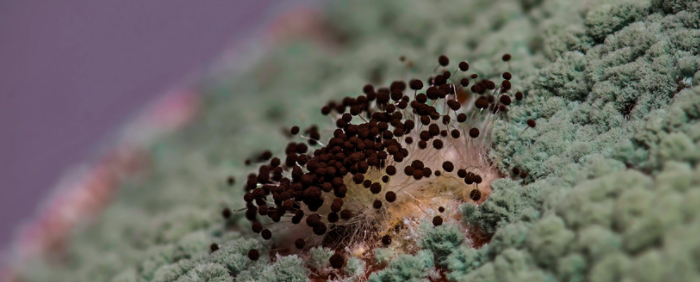
Importance of Trichoderma
Many species of fungi are found in our soil, where some species do damage to the crops (non-beneficial fungus), on the other hand some species are beneficial (beneficial fungus) such as Trichoderma.
Trichoderma is a microscopic activist working continuously with silence in the root configuration zone of plants (Rhizosphere). It is an herbivorous fungus that is often found on organic residues. Therefore, it is an important biological control for the management of many types of crop diseases caused by fungus in the soil.
It grows in the soil and protects the plants from the root area and from the nursery stage of the crop. Approximately 6 specimens of Trichoderma are known, but only two Trichoderma viridi and Trichoderma harzianum are abundant in soil.
It is very important and useful in agriculture. It is a bio-fungicide which prevents various types of fungal diseases. This reduces dependence on chemical fungicide. It is used mainly for the prevention of pathogenic organisms. Its use is considered naturally safe because its use does not get any visible side effects in nature.
MEthod of Trichoderma production
In the rural domestic method of the production of Trichoderma, the dung cakes are used. At the shady place in the field, the dung cakes are scrapped. It is mixed with water and mixed with hands. So that the pile of condensation began to look dark brown.
Now the 60gm / 28Kg dung cakes, trichoderma pure culture of high quality is mixed in the heap. Cover the heap well with an old jute sack and then soak the sack with water. Spraying of water from time to time on the sack, keeps proper moisture content in the heap.
After 12 to 16 days, shake the heap thoroughly from the shovel to the bottom. And again fold the sack. Then keep spraying water from time to time. After about 18 to 20 days, the green colour begins to appear on the puddle. In about 28 to 30 days, the whole green is visible. Now this can be used for soil treatment.
Simple, cheap and high quality Trichoderma is now ready at your home. To prepare the new structure again, you can preserve some part of the already ready Trichoderma and thus use it as a mother culture for new tissue. We will not have to buy mother culture from time to time.
SEED Treatment
For the treatment of seeds, add 5 grams of powder per kg of seeds. This powder sticks on the seed so there is no need to soak the seed because the powder contains carboxy methyl cellulose.
With the formation of seeds, the form of Trichoderma also grows all around in the soil and surrounds the root all the way so that most of harmful fungi can not grow around, which keeps up till the last stage of the crop.
Soil Treatment
Mix 1 Kg of Trichoderma powder in 25 Kg cow dung (Farm Yard Manure) and keep it in a shade for one week so that the spores get frozen then spread it over one acre of soil and sow it later. 5 days before planting, add 150 grams of powder to 1 m2 and depth of 4-5 cm in soil, then sow it again. If the problem comes later, then the powder can be inserted around the trees by making a garnet or a drain so that it can reach the root of the plants.
Seed priming
Before planting seeds, laying of special type of slurry on the seeds and then drying in shade is called seed priming. First, make slurry of cow’s dung to make seed priming from Trichoderma. Mix 10 grams of Trichoderma products in the dung liquid per litre and dip about one kilogram of seeds in it. Take it out and let it dry in the shade a little while then sow it again. This process should be done especially before sowing of cereals, pulses and oilseeds crops.
Perfusion Spraying
For the prevention of certain types of diseases, such as leaf spots, scorching etc., spray by sprinkling 5 – 10 grams of Trichoderma per litre of water.
Root treatment
Add 250 grams of Trichoderma to 10 to 20 litres of water and keep the roots of plants implanted in the mixture for 30 minutes and tuber, rhizome and stem in that solution for 15 to 30 minutes.
Benefits of Using Trichoderma
It prevents the growth of pathogenic organisms or kills them and keeps plants disease-free.
It enhances the immune system in plants by changing the chemical processes of plants.
It activates the mechanism of systemic acquired resistance (Systemic Acquired Resistance) against the pathogens in plants. It increases the rate of decomposition of organic matter in the soil, so it works like organic fertilizer.
It enhances the antioxidant activity in plants.
It increases the growth of plants because it makes phosphate and other microbial nutrients soluble. There has been an increase in the number of deep roots in grass and many other plants, which gives them the ability to grow in drought.
These insecticides play an important role in the bioremediation of soil contaminated with insecticides. They have the ability to destroy various types of insecticides such as organophosphate and carbonate pesticides.
Precautions
Do not use chemical fungicide until 4 to 5 days after using Trichoderma in the soil.
Do not use Trichoderma in dry soil.
Moisture is essential for the development and survival of the Trichoderma.
Do not keep Trichoderma treated seeds in direct sunlight rays.
Do not keep the dung compost treated by Trichoderma for a long time.